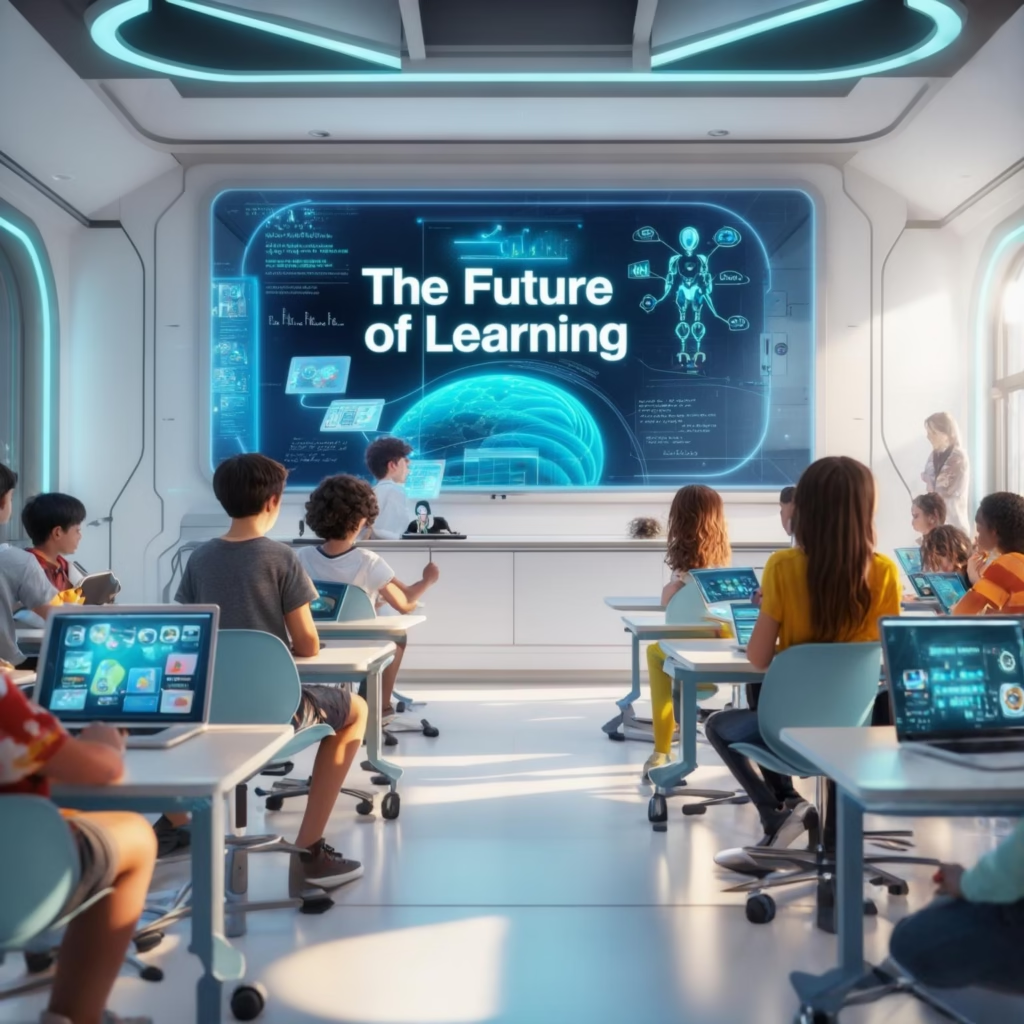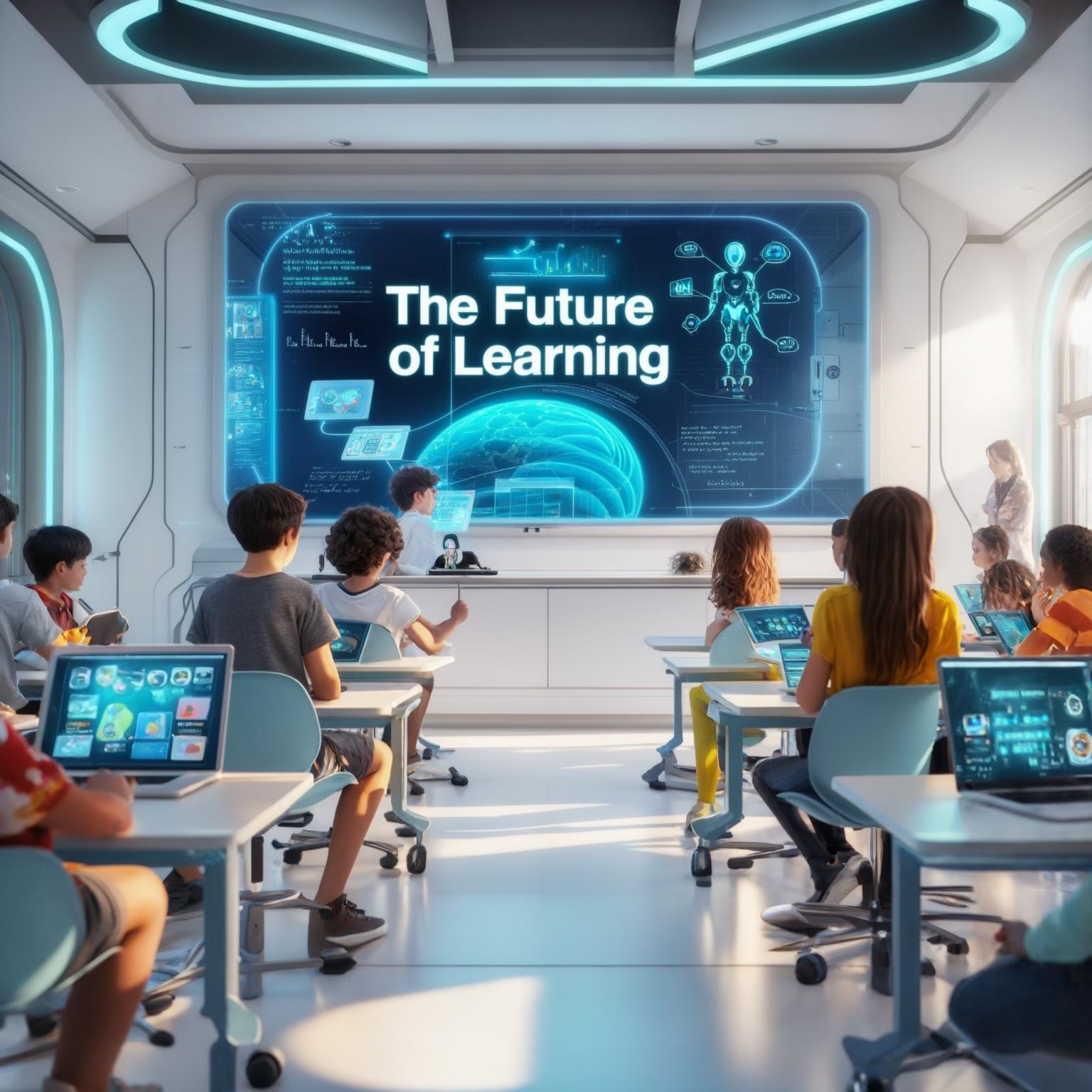The Future of Learning: Cutting-Edge AI Tutors & Intelligent Classrooms for a Smarter Generation 2025
Schools are on the brink of a technology revolution. With artificial intelligence (AI), big data, and smart devices already entering our lives, they are also revolutionizing how we learn and teach. The traditional classroom model is shifting at a rapid rate, and the arrival of AI tutors and smart classrooms is set to make learning more tailored, inclusive, and efficient.

THE RISE OF AI TUTORS: YOUR PERSONALIZED LEARNING COMPANION
AI instructors are learning computer programs that can guide students through lessons, quizzes, and practice problems. These programs use machine learning and natural language processing to adapt to a learner’s learning style, pace, and areas of difficulty.
1. Customized Learning Paths
The most severe failing of traditional learning is the “one-size-fits-all” approach. AI teachers rectify this problem by checking students’ profiles—such as test results, task time gained, and mistake patterns—and updating lessons accordingly. A student who is falling behind in algebra but exceling in geometry will get priority help for algebra immediately, not having to wait for teacher intervention.
2. Instant Feedback & Testing
This is different from human instructors who may take days or hours to grade work. The AI instructor gives immediate feedback. This enables students to understand their errors and adjust their approach in a timely fashion. Over time, this speeds up learning and enhances retention.
3. 24/7 Access
AI teachers are not limited by school schedules. A student who is a late-night or early-day person can be just as well helped. This is particularly useful for students who have work or family commitments that need to be synchronized with school.
SMART CLASSROOMS: CONNECTED, INTERACTIVE, AND IMMERSIV
A smart classroom integrates digital technologies such as interactive whiteboards, AR/VR, IoT sensors, and cloud-based learning platforms to build a dynamic, immersive learning environment.
1. Interactive Learning Spaces
Interactive screen displays substitute traditional blackboards, allowing the instructor to present lessons in richer multimedia content—videos, animations, simulations, and live data. The multi-sensory learning process stimulates students and makes it easy to explain complex information.
2. Real-Time Monitoring & Analytics
Smart classrooms use sensors and AI software to monitor students’ engagement, attendance, and level of understanding. Instant alerts are provided to the teacher in case a student is lagging behind or distracted, allowing intervention at the optimal time.
3. AR/VR for Immersive Learning
Technologies like VR and AR are converting theoretical learning into experiential learning. History students, for example, go through old cities wearing VR headsets or learn the human body in biology classes. Learning becomes more memorable, and practice is brought closer to theory.
BENEFITS OF AI AND SMART CLASSROOMS
The integration of AI and smart technology in education provides a set of transformational benefits:
1. Equity and Inclusion
AI can be configured to accommodate content for disabled students. Speech-to-text, text-to-speech, graphics, and gesture software equalize learning for everyone. Language translation software also offers students a chance to learn their native language.
2. Empowerment of Teachers
Though AI displacing teachers is a nightmare, smart technologies empower teachers instead. As technology handles mundane work like grading, attendance, and lesson planning, teachers can dedicate their efforts to committed mentorship, creativity, and personalized mentoring.
3. Scalability
AI systems can educate thousands, even millions, of students simultaneously. That’s a revolution in underdeveloped communities where trained teachers are few in number.
4. Ongoing Learning
Intelligent systems enable ongoing learning through adaptive, self-learning. Working professionals and students can reskill and skill-up at their convenience from anywhere through AI-based learning platforms and mobile learning applications.
CHALLENGES TO BE OVERCOME
While promising in its implications, the revolution in education by AI and smart classrooms is full of vital challenges:
1. Privacy and Data Security
Intelligent classrooms and AI teachers heavily rely on student information. Secure protection of such information and ethical application is significant. Parents, educators, and policymakers need to favor tight data protection legislation and open AI algorithms.
2. Digital Divide
Not everybody owns devices, has internet access, or is technically literate. If left unchecked, introducing smart technologies would further widen educational inequalities. Governments and non-government organizations need to work together to make technology accessible and affordable.
3. Training Teachers
Professionalization of teachers is necessary for efficient use of AI and smart tools. They need to be instructed in new pedagogical approaches, technical classroom management, and low-level technical fixes.
4. Technological Over-Reliance
Technology makes learning easier but can’t replace human interaction, thinking, and emotional quotient. There needs to be a balance in order to give students a holistic education.
FUTURE OUTLOOK: WHAT TO EXPECT IN THE NEXT DECADE
The next decade will witness frenetic growth in AI, 5G, quantum computing, and edge computing—all of which will continue to revolutionize education.
1. Hyper-Personalized Education
With AI becoming more sophisticated, we’ll see systems that predict student success, recommend optimal learning paths, and adapt teaching in real-time. Education will become a tailored experience, much like personalized playlists on Spotify or Netflix.
2. Global Classrooms
With intelligent translation software and international connectivity, virtual classrooms will unite students and instructors across the globe. Cross-cultural interaction will enhance communication skills as well as global awareness.
3. Gamification and Motivation
AI-driven gamified learning environments where students can earn points, badges, and levels will be utilized. Reward systems will motivate learners to remain interested, especially in the STEM courses that are commonly believed to be difficult to study.
4. Emotional AI
Next-generation AI educators will not only understand what students understand, but how they feel, too. With analysis of tone, facial expressions, and posture, the systems will offer compassionate feedback, nudging learning to a human standard.
REAL-WORLD EXAMPLES
Some edtechs and schools are already leading the way:
Squirrel AI (China) uses deep learning to personalize tutoring for over 1 million students.
Byju’s (India) employs AI and animation to explain topics in an interactive and easy-to-use manner.
AltSchool (USA) was one of the first of a smart school environment where every child learned a customized digital curriculum.
Governments also are waking up. The National Education Policy 2020 (India) emphasizes digital infrastructure and e-learning. These kinds of policies are being designed everywhere around the world to facilitate the use of technology in the classroom.
CONCLUSION: THE CLASSROOM OF TOMORROW
Learning is the future and it’s smart, networked, and inclusive. Intelligent classrooms and AI tutors are not trends—they are harbingers of a revolution in how we think about learning. These technologies can close learning gaps, empower imagination, and prepare students for the future.
But in order to achieve this vision justice, stakeholders will need to resolve questions of accessibility, privacy, and teacher education. Well-conceived and used ethically, AI and smart technologies are able to not only make education smarter but also more human.

